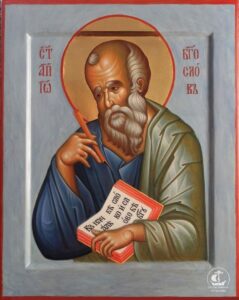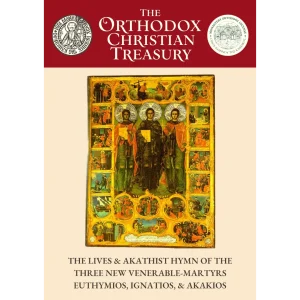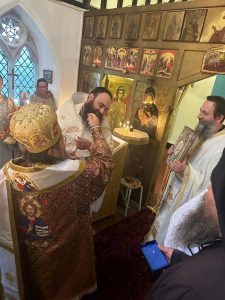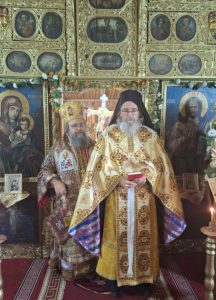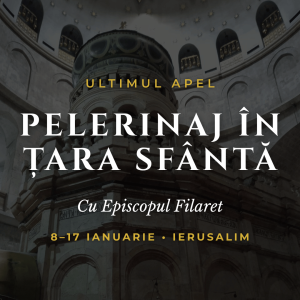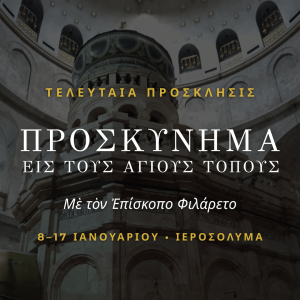SAINT ALFRED, MARTYR-PRINCE OF ENGLAND by Dr. Vladimir Moss
The ancient town of Guildford is dominated by two hills, between which flows the River Wey. On top of one hill there stands the church of St. Martha. It is likely that the word “Martha” was originally “Martyr”, for the parish and the church are called “Marterhill” in many early documents. Moreover, in a document dated 1463 it is called “the chapel of St. Martha the Virgin and all the holy Martyrs commonly called Marterhill near the town of Guldeforde”. According to a well-established tradition, these martyrs were burned to death on the hill in Saxon times, perhaps around 600 A.D. during a pagan reaction against the missionary activities of St. Augustine, first archbishop of Canterbury. On the other hill, known as Guildown, another martyrdom took place over 400 years later. The story is as follows. The holy Martyr-Prince Alfred was the son of King Aethelred “the Unready” of England, and brother of the future king and saint, Edward the Confessor. With his brother, he spent many years in exile, following the expulsion of the English royal family to Normandy in 1016 by the Danish King Canute. On the death of Canute, however, in 1035, the princes’ mother, Queen Emma, judged that the political situation had changed in England, and invited her sons to join her at Winchester. Edward came first, but was forced to return to Normandy after a battle in the Southampton area. Then came Alfred, the younger prince. Having selected some companions with his brother’s approval, he went first to Flanders, where he stayed with Marquis Baldwin. Then he set out from Boulogne and crossed the English Channel. On approaching the shore, however, he was recognized by the enemy, and was forced to land at another port further down the coast. Finding no opposition there, he set off inland. As Alfred and his men approached the town of Guildford, thirty miles south-west of London, they were met by the powerful Earl Godwin of Wessex, who professed loyalty to the young prince and procured lodgings for him and his men in the town. The next morning, Godwin said to Alfred: “I will safely and securely conduct you to London, where the great men of the kingdom are awaiting your coming, that they may raise you to the throne.” This he said in spite of the fact that the throne was already occupied by the son of Canute, Harold “Harefoot”. Events were to show that Godwin was not sincere. He was actually in league with King Harold to lure the young prince to his death… Then the earl led the prince and his men over the hill of Guildown, which is to the west of Guildford, on the road to Winchester, not London. Perhaps the prince had insisted on continuing his journey to his original destination, his mother’s court in Winchester… In any case, Godwin repeated his tempting offer; showing the prince the magnificent panorama from the hill both to the north and to the south, he said: “Look around on the right hand and on the left, and behold what a realm will be subject to your dominion.” Alfred then gave thanks to God and promised that if he should ever be crowned king, he would institute such laws as would be pleasing and acceptable to God and men. At that moment, however, he was seized and bound together with all his men. Nine tenths of them were then murdered. And since the remaining tenth was still so numerous, they, too, were decimated. Alfred was slung naked to a horse and then conveyed by boat to the monastery of Ely. As the boat reached land, his eyes were put out. For a while he was looked after by the monks, who were fond of him, but soon after he died, probably on February 5, 1036, and was honourably buried by the monks in the southern porch at the western end of the church. There wondrously beautiful visions of light were often reported, and many miracles were performed. He was the object of local veneration; and “justly so,” says the Encomium Emma Reginae, “for he was martyred in his innocence”. Although Godwin denied any complicity in the murder (according to the Encomium, Harold’s men took the captive, including Alfred, out of Godwin’s hands), both popular opinion and that of King Edward, the prince’s brother, pointed the finger at him. On the Monday after Pascha, 1053, the earl was feasting with the king when a waiter in his haste struck one foot against some obstacle and nearly fell. But, advancing his other foot, he recovered his balance. Many of those present joked, saying how right it was that one foot should help another. And the earl cried out: “So should one brother help another, and a man may support his friend in time of need.” At which the king, turning towards him, immediately replied: “So should my brother have helped me if Godwin had allowed it.” At this Godwin turned pale, and with a distorted countenance exclaimed: “Well do I know, O king, that in your mind you hold me guilty of your brother’s death. Well do I know, alas, that you do not disbelieve those who say that I was a traitor to him and to you. But let God Who knows all secrets be my judge! May this crust of bread which I hold in my hand pass through my throat and leave me unharmed to show that I was innocent of your brother’s death!” He spoke, and putting the crust into his mouth he thrust it into the midst of his gullet. Then he tried to push it further but was unable. Then he tried to pull it out but it stuck ever more firmly. He choked; his eyes turned up, and his limbs grew rigid. The king watched his wretched death, and then said to those standing by: “Drag out that dog.” In the 1920s, archaeological excavations on Guildown, Guildford, discovered the bones of about two hundred men, their skulls being of the round-headed, Norman type, in a shallow grave dating back to about 1040. It appears that they had been stripped and their hands tied behind their backs before being killed and thrust into the grave. An Orthodox church dedicated to the holy Archangel Michael now stands about one hundred meters from this grave. Holy Martyr-Prince Alfred, pray to God for us!
(Sources: Andrew Holden, The Story of the Church of Saint Martha on the Hill near Guildford, second edition, 1967; Encomium Emma Reginae; The Anglo-Saxon Chronicle; Anonymous, Vita Aedwardi Regis; Liber Eliensis, II, 90; Geoffrey Gaimar, L’Estoire des Engleis, p. 788; William of Poitiers and John of Brompton, in E.W. Brayley, A Topographical History of Surrey, vol. I, London: Willis, 1850, pp. 287-88; Ailred of Rievaulx, in D.C. Douglas, William the Conqueror, London: Eyre Methuen, 1969, pp. 412-13; A.W.G. Lowther, “The Saxon Cemetery at Guildown, Guildford, Surrey”, Surrey Archaeological Collections, vol. XXXIX, 1929-30; Letter of the Dean of Ely, the Very Revd. M.S. Carey, January 6, 1978; Peter Rex, Edward the Confessor King of England, Stroud: Amberley, 2013, pp. 28-32)

